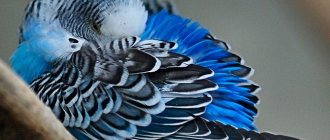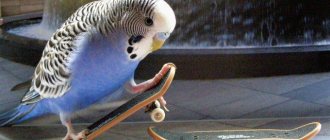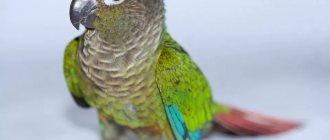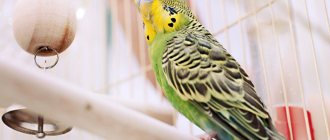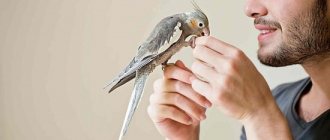Why parrots love mirrors
The fact that parrots love mirrors is known to many. But not everyone knows why this item is so popular with exotic birds.
Parrots are considered sociable, socialized birds that choose a gregarious lifestyle in the wild. Their bird colony is a big “family” where you can feel protected, because there will always be those who will notify you of a threat, where you can practice your “singing” skills, even just have someone to “talk” with on hot evenings among the treetops.
Those individuals who have the role of pets can only “talk” with a cage neighbor (but there is not always one) or with a person. And if you consider that the owner can usually devote no more than a few hours a day to his feathered friend, then the bird is left alone and begins to get bored. A “single” life without communication has a negative impact on the health of feathered pets, and can even cause an early death.
But a mirror for parrots is just that device that can become a kind of “friend”. Naturally, he does not understand that the parrot sees his reflection, but he clearly understands that in front of him is a bird from “his” circles. Communicating with your image partially solves the problem of boredom and loneliness.
Wavy and mirror
Negative aspects of the issue
Let us remember that wavy animals are extremely sociable. By inviting him to start a friendship with himself, we are cynically deceiving him, because this way we can only find a surrogate relationship.
Negative aspects for a parrot
Even if he does not understand the essence of this substitution, sooner or later he will get tired of being an outcast and will instinctively resist this state of affairs. From here, aggression will appear first, then mental and physical illnesses.
The bird will never be able to understand that there are no other birds in the room. She is happy to communicate even with her own shadow (only because the owner pays little attention to her). The man is somewhere far away, and the handsome neighbor is behind the glass. Gradually, the parrot will completely move away from the owner. Some even refuse to leave their cage because they have lost interest in people forever.
This attitude will definitely affect your health. The bird moves little, eats poorly (but offers food to the reflection!). And then despair sets in, hatred for the whole world manifests itself. Wavy will try to break the mirror. He will definitely succeed. It's good if he doesn't swallow anything.
Aggression is often directed at the owner, as if it is his fault that the bird’s virtual communication is not working. Who else? It is the person who must answer for breaking the psyche of his pet. I know a case where a bird rushed straight into the owner’s face; miraculously, the eyes were not damaged, but the scratches were deep and took a very long time to heal.
Should I put a mirror on my parrot?
Probably, supporters and opponents of such entertainment will never agree with each other. We will try to find the lesser of two evils: let there be such an accessory, but a safe one.
Does a parrot need a mirror in its cage?
Budgerigars like a potential “friend” from through the looking glass. Sometimes you can observe how a bird coos in front of its reflection, “kisses” it, and tries to “talk”.
But such harmless chirping can cause harm, because over time the bird begins to understand that there is no response, and may even become nervous because of this. Therefore, opinions among breeders differ about whether a parrot needs a mirror, and each side gives its own arguments.
| pros | Minuses |
| The constant presence of a “neighbor”. An opportunity to pass the time in the game during a short absence of the owner. Strengthening speaking skills. | May get hurt when trying to attack. Provokes hypersexuality in males. Depression, increased nervousness, apathy in the absence of a response from the “interlocutor”. A gradual decrease in communication with people (with a lack of attention from the person), isolation. Muscle atrophy from prolonged sedentary stay in one place. Increased pain. |
Under no circumstances should you hang a mirror used by humans in the cage, as the bird may break it and injure itself. They sell special plexiglass devices for parrots.
Avoid the plexiglass device altogether if:
- two or more budgies live in a cage;
- the process of taming young animals goes through;
- the bird becomes lethargic after spending time with its reflection.
What toys can you use to entertain your feathered friend?
Other owners take an alternative route and, instead of a mirror, buy toys and various accessories for their pet to have fun. Toys are not only a great way to entertain your bird while you are away from home, they are an important element in your pet’s physical and psychological development. Thanks to joint games, you can establish a close connection with the bird, make friends and tame the bird.
All types of parrots love to play with bells, rattles, chews, balls, swings, beads, cars, ladders, and windmills. Your task is to choose a toy according to the size and abilities of your pet. Birds themselves choose some objects as entertainment, showing sympathy for one form or another (color). A small basketball court is a great way to have fun with your pet, who will love throwing balls.
You can also buy a small piggy bank and teach your pet to throw coins into it. Birds like to carry toy carts, throw rings on a post, and sort cubes by color or size. You can also find mirrors specially equipped with bells and balls. Additional trinkets will make your little friend more interested.
Did you know? Once in the USA, a pet parrot helped solve an apartment robbery case. The thieves did not hesitate to call each other by name. The parrot remembered these names and then repeated them many times in the presence of law enforcement officers, which helped the police get the right trail.
It is better to purchase toys in specialized pet stores. Cheap Chinese plastic is dangerous for birds - they can crumble it, swallow it, and also get injured or poisoned by low-quality material. Threads, ropes and ropes must be made from natural materials (linen, cotton, sisal, jute or hemp). If you see that the parrot has ruffled such material, you should either replace it with a new one or remove the toy from the bird.
Based on your pet's preferences, you can make a toy for him with your own hands. Beautiful accessories are made from branches of fruit trees. When creating toys, do not forget about safety rules. If you want to make a toy from wood, then before use, boil and rinse the branches well under running water. Cardboard paper and paper towel tubes can be annealed in the microwave.
Important! Branches of oak, pear, bird cherry and poplar are dangerous for birds, so they should not be used to create toys. In addition, the cage should not contain metals such as zinc, copper and brass.
After purchasing a toy in a store, you should first disinfect it: treat it with boiling water, then pour it with chamomile tincture and wait until it dries. Mirrors, toys and play stands should be washed from time to time (as they become dirty). There is simply no single answer to the question of whether it is worth hanging a mirror in a parrot's cage.
Often the problem lies in the individual characteristics of the bird. The best adviser here can only be your love and intuition, attention and care. If a mirror brings joy and positive emotions to your pet, if this accessory helps the parrot develop and does not suppress the psyche, there is no point in depriving him of his favorite toy.
Why can a parrot hit a mirror?
If your budgerigar often hits its head on the surface of the mirror, it is worth finding out the reason for this behavior.
According to experienced breeders, such an inadequate reaction to an accessory can be caused by the following reasons:
- a specific manner of behavior with relatives;
- perception of what is seen in the role of an enemy or rival;
- flirting, courtship;
- some way of playing.
All of the above reasons are a variant of the norm.
It is worth noting that a bird can have contact with the mirror not only in the cage, but also when walking. Large mirrors in rooms are a leading cause of serious injury to birds when they crash into them while flying. Some birds, after several collisions, already try to fly around an unsafe object. But hoping that the bird will always be careful is also not particularly worth it.
Therefore, to prevent injury, you should take the following measures:
- try to walk your pet where there are no mirrors;
- cover room mirrors with thick fabric;
- distract the bird from the mirror with other things or joint games.
Which mirror to choose for your pet
If you choose to purchase this accessory, you need to consider several points.
This can be dangerous for several reasons. Firstly, such an object breaks, and it is impossible to predict the pet’s reaction to its image in the mirror. Birds often hit it with their beaks, causing cracks to appear. In the worst case, the brittle material shatters into fragments. As a result, substances hazardous to the health of the bird - they are used in the manufacture of this item - can enter the body of the budgerigar and cause poisoning. Injury from sharp fragments is possible.
A good option is plexiglass. You need to choose such accessories in special pet stores.
There are even options such as “two in one”: a mirror plus a feeder or perch. In this case, the risk that the pet’s image will completely absorb it is reduced: the parrot will inevitably begin to pay attention to other objects.
The decision about whether to install a mirror in a parrot's cage is made by each breeder independently. It is important to take into account the age and character of the pet, how much time he spends alone and how far he has progressed in training.
If you minimize possible risks, this accessory will become a very useful item in your parrot’s home.
Keeping at home
The extensive practical experience of numerous poultry farmers shows that caring for a Corella parrot at home is quite simple. You just need to adhere to some mandatory rules.
Cell selection
Corella is not a wavy bird, so it needs a fairly spacious place to keep it. The cage dimensions should be 40 x 50 x 100 cm per pet. The shape should be rectangular. The cage door must be equipped with a secure lock so that the bird cannot open it on its own. For owners of a private home with several parrots, it would be preferable to equip an aviary.
The cage should be made only from high-quality, durable and environmentally friendly materials. The quality of execution must be high.
There should be no small chips or burrs on its surface.
Home improvement
The following must be installed inside the cage:
- Drinkers in which the water needs to be changed every day, and in the summer this can be done twice or three times.
- Feeder (preferably more than one, so that only one type of food can be placed in one feeder, which is convenient for both the parrot and its owner)
- Bathing suit. This accessory is very important because the bird takes a bath there.
- Perches. It is better to make them from tree branches. But you can also buy ready-made ones in the store.
- Toys. These include ladders, swings, rope ropes, and bamboo rings.
- Devices for grinding beaks. It can be mineral stone or sepia.
Temperature and light conditions
The microclimate in the room where the Corella parrot is kept should resemble the natural conditions in its habitat - Australia. The air temperature should be from 18 to 25 degrees Celsius. The air humidity must be maintained at approximately 70%.
It is strictly not recommended to install the cage near heating devices. The room with the parrot must be regularly ventilated. It is necessary to prevent the parrot from being in a draft. The cage can be moved to another part of the room, less airy, or moved outside it.
The recommended sleep duration for birds in summer is at least 10-12 hours. In winter, it increases to 12-14 hours. Therefore, it is necessary to regulate the duration of daylight hours. In winter, the cage needs to be illuminated in the evening, when darkness has already set in. You can do this in the morning.
In summer, on the contrary, it is necessary to cover it with a cloth and create an artificial night so that the pet understands that it is time to sleep. If the owner regularly performs this activity, the bird will not wake him up in the morning with its singing. The Corella will sit calmly on her favorite perch.
Purity
Cockatiels leave quite a lot of trash behind. Therefore, their cages must be regularly cleaned and disinfected. The cage floor, feeder and water bowl should be washed daily. Perches and toys can be washed as they become dirty.
About once a week you need to disinfect the cage. This will be a good prevention of all kinds of diseases.
Imaginary friend
But no matter how much a parrot looks at itself in the mirror, it will never understand that this human invention only reproduces its own reflection.
The bird's highly developed intelligence, coupled with excellent eyesight, gives the parrot the illusion that a fellow parrot is sitting in the mirror. Therefore, the further relationship between the parrot and his “imaginary friend” depends only on the character of the bird itself.
Causes and methods of solving the problem
If a parrot hits a mirror, then it is necessary to find out the nature of the strange behavior. Among the reasons are the following factors:
All causes of unusual behavior are normal and do not require special measures. If the ward takes off for a free flight for the first time, then he may perceive the mirror as an extension of the room. In this case, the owners note that the parrot hit the mirror during the flight. This phenomenon must be excluded, as the pet can receive serious injuries. To avoid severe situations, you should do the following:
Some individuals, after the first collision, understand that it is impossible to fly further and do not fight anymore. Therefore, there is no need to carry out special events. If the pet continues to hit the object, it is necessary to block access to the mirror while the bird is flying. Similar actions apply to glass and windows. Openings should be covered with curtains.
Upbringing
Thus, a mirror for a parrot is not an ordinary toy like swings and bells, but a living bird: friend or foe.
The only unexpected thing for the owners may be the parrot’s reluctance to communicate with them. Some individuals are so keen on communicating with their own reflection that they do not leave the cage, even if the door is constantly open.
Therefore, it is recommended for the first time (1-2 months) to spend as much time as possible with the bird, letting it get used to your hands, voice and learn a few words with it. After this, you don’t have to be afraid that the bird will prefer its “looking-glass friend” to its own owner.
